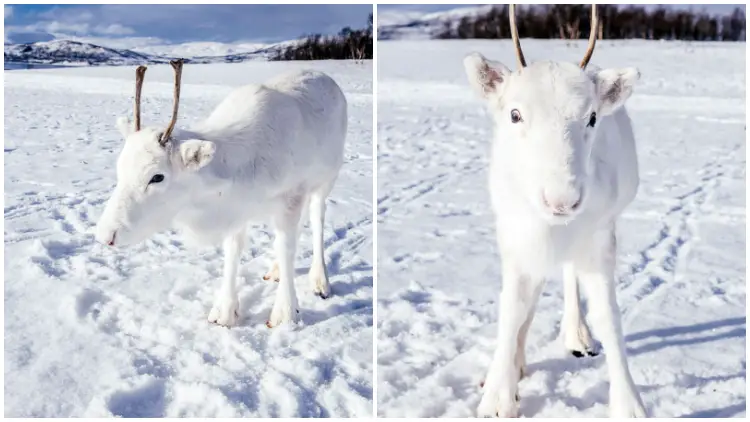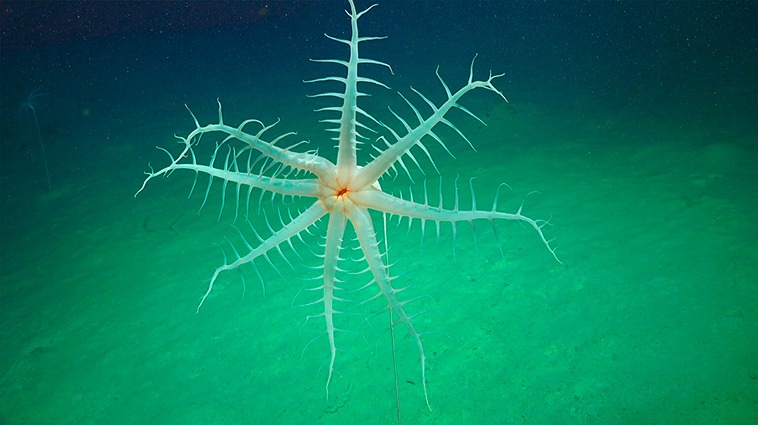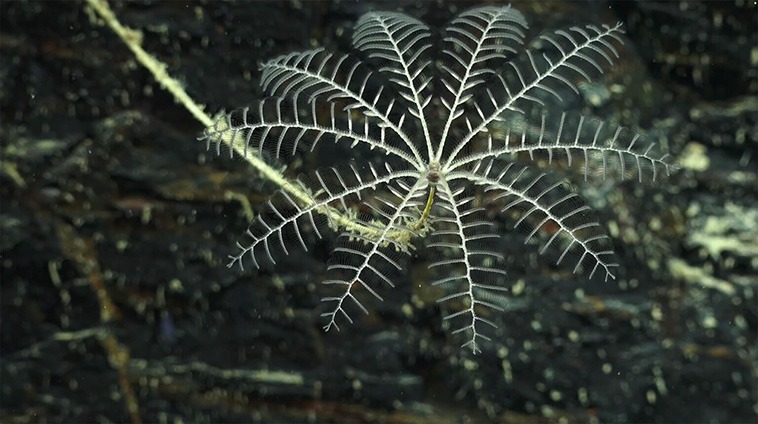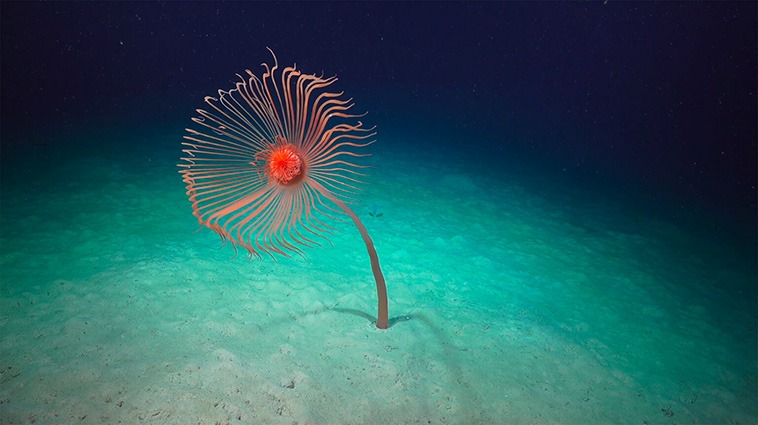ANIMALS
Stunning White Baby Reindeer Was Spotted in The Glistening Snow, Creating a Magical Moment

White reindeer, also known as leucistic deer, are a rare sight and make up less than one percent of the deer population. Spotting them in snowy conditions can be even more difficult due to their camouflage. However, a fortunate photographer stumbled upon one of these elusive creatures while hiking in Norway, creating a magical experience.
Mads Nordsveen has captured breathtaking views of many wonders across the world, but it was a humble and pure creature that caught his attention and left a lasting impression on him.
While hiking with friends on the northern Norwegian island of Senja, Mads Nordsveen, and his companions came across a white reindeer calf one morning, blending in perfectly with the snow-covered ground around them.
 Image source: Mads Nordsveen
Image source: Mads Nordsveen
On that enchanting morning, the calf almost blended in with the snow. With bone-colored antlers piercing the air, and dark eyes being the only prominent feature, it could have easily been mistaken for another pile of snow.
 Image source: Mads Nordsveen
Image source: Mads Nordsveen
Nordsveen noticed a brown reindeer standing a short distance away, which he believed to be the calf’s mother. The group remained still, quiet, and calm in order to approach the calf without disturbing it.
 Image source: Mads Nordsveen
Image source: Mads Nordsveen
The photographer had only a brief moment to capture the baby reindeer’s presence before it ran back to its mother and disappeared into the woods, but that was all it took to ignite his artistic inspiration.
 Image source: Mads Nordsveen
Image source: Mads Nordsveen
Nordsveen was informed by the Sami people, who have been herding reindeer in northern Norway, that white reindeer are incredibly uncommon and are considered to bring good luck. This made the encounter even more memorable for the fortunate photographer.
 Image source: Mads Nordsveen
Image source: Mads Nordsveen
 Image source: Mads Nordsveen
Image source: Mads Nordsveen
ANIMALS
Amazing Video of Unseen Ocean Creatures in the Ningaloo Canyons

The Schmidt Ocean Institute recently explored the Ningaloo Canyons on the western coast of Australia using a robotic underwater vehicle called the ROV Sebastian. Check out the amazing video of what they discovered in the deep parts of the Indian Ocean.
More info: Youtube




ANIMALS
These Pics Are Art and the Artists Are Insects

Flying insects move so quickly that they are hard to follow, but new technology and some smart ideas have helped Spanish photographer Xavi Bou do just that. After spending 10 years focusing on birds in flight for his Ornithographies project, he turned his attention to insects.
For Entomographies, he uses high-speed video footage taken by Adrian Smith, an insect expert at North Carolina State University, to study and record how insects move. Bou then picks multiple frames and combines them into single images that show the fast movements of one or more insects through space and time.
With Smith’s help, Bou has captured the aerial tricks of wasps, the jumps of leafhoppers, and the fluttering of butterflies in amazing detail. He hopes that by doing this, he can make people more aware of the decline in important insect populations around the world.
1. Zebra longwing
This butterfly, which is common in many areas of the Americas, really fits its name. It can fly very high with just a few flaps of its large wings.
 Image source: nationalgeographic
Image source: nationalgeographic
2. Two-lined spittlebug
This insect, which comes from the eastern United States, is often seen as a pest because it likes to eat grass. Its springy back legs can make it jump into the air like a rocket.
 Image source: nationalgeographic
Image source: nationalgeographic
3. Yellow-collared scape moth
Unlike most moths, this North American species flies during the day. Its shiny blue-black wings sparkle in the sunlight.
 Image source: nationalgeographic
Image source: nationalgeographic
4. Ailanthus webworm moths
These tropical moths have spread farther north in the U.S. Because of their larval host, the invasive tree of heaven, they are now one of the most common backyard moths in the country.
 Image source: nationalgeographic
Image source: nationalgeographic
5. Common stonefly
Mostly found in eastern North America, this insect starts its life as an underwater nymph in forested streams or rivers. Then it leaves the water, sheds its skin, and becomes an adult with wings.
 Image source: nationalgeographic
Image source: nationalgeographic
6. Green lacewings
Eighty-seven species of this insect have been found in the U.S. and Canada. Since they eat a lot of unwanted plant pests like aphids and mites, they are often used to naturally control these pests.
 Image source: nationalgeographic
Image source: nationalgeographic
7. Grapevine beetle
This insect, fittingly named, eats the leaves and fruit of grapevines, both wild and farmed, but it doesn’t do much damage to the plants. As a type of scarab beetle, it often flies in a curved path.
 Image source: nationalgeographic
Image source: nationalgeographic
8. Oak treehopper and green treehopper
Treehoppers are known for their uniquely shaped pronotum, the part behind their head, which often looks like plant parts to hide from predators. They can jump well thanks to special muscles.
 Image source: nationalgeographic
Image source: nationalgeographic
9. Banded orange
This brightly colored butterfly can be found from Mexico to Brazil. Before mating season, male butterflies look for mineral salts, sometimes even drinking salty fluids from the skin, eyes, and nostrils of other animals.
 Image source: nationalgeographic
Image source: nationalgeographic
10. Sapho longwing
Longwings can live for 6 to 7 months, longer than most butterflies. This type, found from Mexico to Ecuador, has shiny blue wings, which is why it’s also called the Sapphire longwing.
 Image source: nationalgeographic
Image source: nationalgeographic
ANIMALS
Eagle and Fox in an Epic Midair Battle Over a Rabbit, Were Captured by a Photographer

Wildlife photography often depends on the perfect combination of good timing and the right place.
That’s exactly what happened when Kevin Ebi, an experienced wildlife photographer, captured an incredible battle between a bald eagle and a red fox, both competing for a rabbit meal.
In a detailed blog post, Ebi shares the fascinating series of events that unfolded while he was photographing foxes in San Juan Island National Historical Park, located in Washington state.
Ebi noticed a lively group of eight fox kits as they began their hunting lessons. Suddenly, they spotted a rabbit, and a thrilling chase ensued. Eventually, one of the foxes emerged as the winner, proudly carrying the rabbit across the field.
 Image source: Kevin Ebi
Image source: Kevin Ebi
Ebi shares what happened at that moment: “As I followed the fox with my camera, a sudden bald eagle cry caught my attention. It was swiftly approaching, clearly aiming for the rabbit. I quickly focused on the fox, anticipating a quick turnover of events.”
To Ebi’s astonishment, instead of a quick surrender, the situation turned into a intense fight in the air.
The eagle used its power to lift the fox and rabbit high up in the sky. Even while airborne, the fox attempted to break free by swinging back and forth.
 Image source: Kevin Ebi
Image source: Kevin Ebi
 Image source: Kevin Ebi
Image source: Kevin Ebi
 Image source: Kevin Ebi
Image source: Kevin Ebi
In the end, the eagle moved the rabbit to its other claw, causing the fox to let go. The intense battle came to an end in less than 10 seconds.
 Image source: Kevin Ebi
Image source: Kevin Ebi
For those worried about the fox’s well-being after the fight, Ebi reassures that it was not injured. The fox swiftly bounced back from the encounter and resumed its playful behavior with the other young foxes, showing no visible wounds from the aerial clash.
 Image source: Kevin Ebi
Image source: Kevin Ebi
 Image source: Kevin Ebi
Image source: Kevin Ebi
 Image source: Kevin Ebi
Image source: Kevin Ebi
 Image source: Kevin Ebi
Image source: Kevin Ebi
-

 GARDEN10 tháng ago
GARDEN10 tháng ago15 Houseplants That Grow Well in Vases with Water
-

 FUNNY1 năm ago
FUNNY1 năm ago20 Funny Grammar Fails That Will Make You Laugh All Day
-

 GARDEN1 năm ago
GARDEN1 năm ago4 Easiest Ways to Get Free Plants
-

 GARDEN11 tháng ago
GARDEN11 tháng ago30 Shimmering Side Yard Landscape Ideas
-

 FUNNY1 năm ago
FUNNY1 năm ago30 Funny and Perplexing Photos That Make You Laugh All Day
-

 FUNNY1 năm ago
FUNNY1 năm ago30 Weirdest Things That People Came Across On The Subway
-

 ANIMALS1 năm ago
ANIMALS1 năm agoBritish Angler Caught Huge 67-Pound Goldfish in the World
-

 ANIMALS1 năm ago
ANIMALS1 năm agoMore Than 3 Million People Baffled by Video of Strange Figure on the Beach




